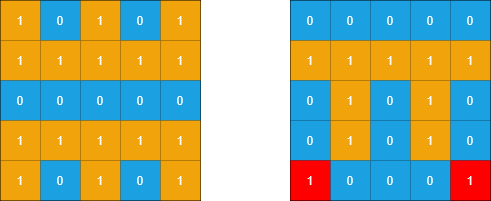| comments | difficulty | edit_url | rating | source | tags | |||||
|---|---|---|---|---|---|---|---|---|---|---|
true |
Medium |
1678 |
Weekly Contest 246 Q3 |
|
You are given two m x n binary matrices grid1 and grid2 containing only 0's (representing water) and 1's (representing land). An island is a group of 1's connected 4-directionally (horizontal or vertical). Any cells outside of the grid are considered water cells.
An island in grid2 is considered a sub-island if there is an island in grid1 that contains all the cells that make up this island in grid2.
Return the number of islands in grid2 that are considered sub-islands.
Example 1:
Input: grid1 = [[1,1,1,0,0],[0,1,1,1,1],[0,0,0,0,0],[1,0,0,0,0],[1,1,0,1,1]], grid2 = [[1,1,1,0,0],[0,0,1,1,1],[0,1,0,0,0],[1,0,1,1,0],[0,1,0,1,0]] Output: 3 Explanation: In the picture above, the grid on the left is grid1 and the grid on the right is grid2. The 1s colored red in grid2 are those considered to be part of a sub-island. There are three sub-islands.
Example 2:
Input: grid1 = [[1,0,1,0,1],[1,1,1,1,1],[0,0,0,0,0],[1,1,1,1,1],[1,0,1,0,1]], grid2 = [[0,0,0,0,0],[1,1,1,1,1],[0,1,0,1,0],[0,1,0,1,0],[1,0,0,0,1]] Output: 2 Explanation: In the picture above, the grid on the left is grid1 and the grid on the right is grid2. The 1s colored red in grid2 are those considered to be part of a sub-island. There are two sub-islands.
Constraints:
m == grid1.length == grid2.lengthn == grid1[i].length == grid2[i].length1 <= m, n <= 500grid1[i][j]andgrid2[i][j]are either0or1.
We can traverse each cell grid2. If the value of the cell is grid1 is also grid1, otherwise it is not. Finally, we count the number of sub-islands in grid2.
The time complexity is grid1 and grid2, respectively.
class Solution:
def countSubIslands(self, grid1: List[List[int]], grid2: List[List[int]]) -> int:
def dfs(i: int, j: int) -> int:
ok = grid1[i][j]
grid2[i][j] = 0
for a, b in pairwise(dirs):
x, y = i + a, j + b
if 0 <= x < m and 0 <= y < n and grid2[x][y] and not dfs(x, y):
ok = 0
return ok
m, n = len(grid1), len(grid1[0])
dirs = (-1, 0, 1, 0, -1)
return sum(dfs(i, j) for i in range(m) for j in range(n) if grid2[i][j])class Solution {
private final int[] dirs = {-1, 0, 1, 0, -1};
private int[][] grid1;
private int[][] grid2;
private int m;
private int n;
public int countSubIslands(int[][] grid1, int[][] grid2) {
m = grid1.length;
n = grid1[0].length;
this.grid1 = grid1;
this.grid2 = grid2;
int ans = 0;
for (int i = 0; i < m; ++i) {
for (int j = 0; j < n; ++j) {
if (grid2[i][j] == 1) {
ans += dfs(i, j);
}
}
}
return ans;
}
private int dfs(int i, int j) {
int ok = grid1[i][j];
grid2[i][j] = 0;
for (int k = 0; k < 4; ++k) {
int x = i + dirs[k], y = j + dirs[k + 1];
if (x >= 0 && x < m && y >= 0 && y < n && grid2[x][y] == 1) {
ok &= dfs(x, y);
}
}
return ok;
}
}class Solution {
public:
int countSubIslands(vector<vector<int>>& grid1, vector<vector<int>>& grid2) {
int m = grid1.size(), n = grid1[0].size();
int ans = 0;
int dirs[5] = {-1, 0, 1, 0, -1};
function<int(int, int)> dfs = [&](int i, int j) {
int ok = grid1[i][j];
grid2[i][j] = 0;
for (int k = 0; k < 4; ++k) {
int x = i + dirs[k], y = j + dirs[k + 1];
if (x >= 0 && x < m && y >= 0 && y < n && grid2[x][y]) {
ok &= dfs(x, y);
}
}
return ok;
};
for (int i = 0; i < m; ++i) {
for (int j = 0; j < n; ++j) {
if (grid2[i][j]) {
ans += dfs(i, j);
}
}
}
return ans;
}
};func countSubIslands(grid1 [][]int, grid2 [][]int) (ans int) {
m, n := len(grid1), len(grid1[0])
dirs := [5]int{-1, 0, 1, 0, -1}
var dfs func(i, j int) int
dfs = func(i, j int) int {
ok := grid1[i][j]
grid2[i][j] = 0
for k := 0; k < 4; k++ {
x, y := i+dirs[k], j+dirs[k+1]
if x >= 0 && x < m && y >= 0 && y < n && grid2[x][y] == 1 && dfs(x, y) == 0 {
ok = 0
}
}
return ok
}
for i := 0; i < m; i++ {
for j := 0; j < n; j++ {
if grid2[i][j] == 1 {
ans += dfs(i, j)
}
}
}
return
}function countSubIslands(grid1: number[][], grid2: number[][]): number {
const [m, n] = [grid1.length, grid1[0].length];
let ans = 0;
const dirs: number[] = [-1, 0, 1, 0, -1];
const dfs = (i: number, j: number): number => {
let ok = grid1[i][j];
grid2[i][j] = 0;
for (let k = 0; k < 4; ++k) {
const [x, y] = [i + dirs[k], j + dirs[k + 1]];
if (x >= 0 && x < m && y >= 0 && y < n && grid2[x][y]) {
ok &= dfs(x, y);
}
}
return ok;
};
for (let i = 0; i < m; ++i) {
for (let j = 0; j < n; j++) {
if (grid2[i][j]) {
ans += dfs(i, j);
}
}
}
return ans;
}function countSubIslands(grid1, grid2) {
const [m, n] = [grid1.length, grid1[0].length];
let ans = 0;
const dirs = [-1, 0, 1, 0, -1];
const dfs = (i, j) => {
let ok = grid1[i][j];
grid2[i][j] = 0;
for (let k = 0; k < 4; ++k) {
const [x, y] = [i + dirs[k], j + dirs[k + 1]];
if (x >= 0 && x < m && y >= 0 && y < n && grid2[x][y]) {
ok &= dfs(x, y);
}
}
return ok;
};
for (let i = 0; i < m; ++i) {
for (let j = 0; j < n; j++) {
if (grid2[i][j]) {
ans += dfs(i, j);
}
}
}
return ans;
}
